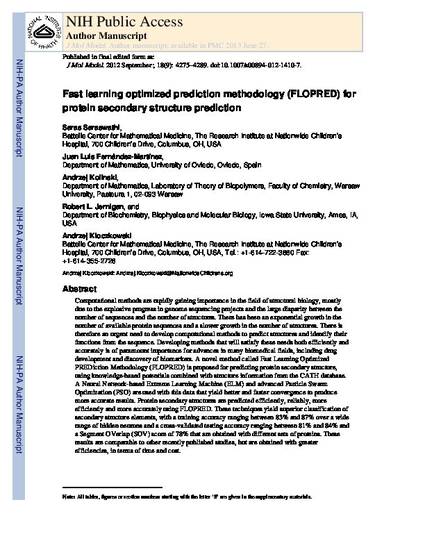
Computational methods are rapidly gaining importance in the field of structural biology, mostly due to the explosive progress in genome sequencing projects and the large disparity between the number of sequences and the number of structures. There has been an exponential growth in the number of available protein sequences and a slower growth in the number of structures. There is therefore an urgent need to develop computational methods to predict structures and identify their functions from the sequence. Developing methods that will satisfy these needs both efficiently and accurately is of paramount importance for advances in many biomedical fields, including drug development and discovery of biomarkers. A novel method called Fast Learning Optimized PREDiction Methodology (FLOPRED) is proposed for predicting protein secondary structure, using knowledge-based potentials combined with structure information from the CATH database. A Neural Network-based Extreme Learning Machine (ELM) and advanced Particle Swarm Optimization (PSO) are used with this data that yield better and faster convergence to produce more accurate results. Protein secondary structures are predicted efficiently, reliably, more efficiently and more accurately using FLOPRED. These techniques yield superior classification of secondary structure elements, with a training accuracy ranging between 83% and 87% over a wide range of hidden neurons and a cross-validated testing accuracy ranging between 81% and 84% and a Segment OVerlap (SOV) score of 78% that are obtained with different sets of proteins. These results are comparable to other recently published studies, but are obtained with greater efficiencies, in terms of time and cost.
Available at: http://works.bepress.com/robert-jernigan/46/

This is a manuscript of an article published as Saraswathi, Saras, Juan Luis Fernández-Martínez, Andrzej Koliński, Robert L. Jernigan, and Andrzej Kloczkowski. "Fast learning optimized prediction methodology (FLOPRED) for protein secondary structure prediction." Journal of molecular modeling 18, no. 9 (2012): 4275-4289.The final publication is available at Springer via http://dx.doi.org/10.1007/s00894-012-1410-7. Posted with permission.